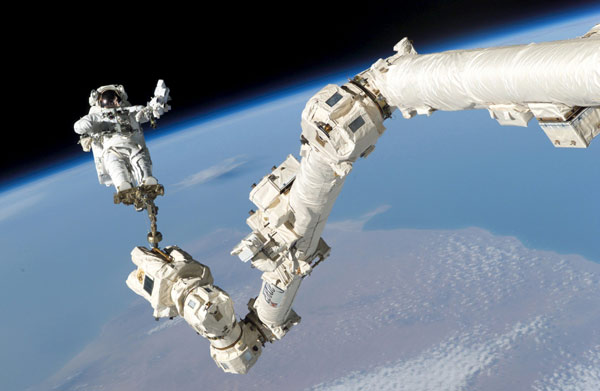Round the world for 18 years: ISS celebrates 100,000 Earth orbits
Updated: 2016-05-24 15:51
(Sputnik)
|
||||||||
 |
|
Astronaut Stephen K. Robinson, STS-114 mission specialist, anchored to a foot restraint on the International Space Station's Canadarm2, participates in the mission's third session of extravehicular activity (EVA) August 3, 2005. FLICKR/ SCOTT KELLY / NASA |
The International Space Station (ISS) has completed 100,000 orbits of the Earth since its first component, the Zarya (Sunrise) Module, was launched on a Russian Proton rocket in November 1998, the Russian Federal Space Agency (Roscosmos) announced on Monday.
"The long life of the ISS illustrates the necessity of permanently orbiting technology for humankind, and the potential for further space exploration," said Maksim Matyushin, head of Roscosmos's Mission Control Center.
"The ISS has become a shining example of genuine and effective international cooperation, combining different engineering cultures, demonstrating the need for international technical cooperation to implement truly ground-breaking projects which are fundamental for the whole of civilization."
The space station orbits at an average altitude of 400 km above Earth and orbits Earth about every 90 minutes, approximately 16 times during a 24 hour day, at a speed of about 28,000 kph.
Construction of the space station's first module began in 1994 at the Khrunichev State Research and Production Space in Moscow, under a subcontract to Boeing for NASA.
The ISS currently consists of 15 modules and weighs more than 400 tons, making it the largest structure that has been put together by humankind in space.
The space station has been visited by more than 100 vehicles, and has been continuously manned since November 2000; 222 people from 15 different countries have spent time there.
Between three and six astronauts call it their home at any time, and each expedition arrives aboard the Soyuz spacecraft, which also transports equipment and supplies.
In March, NASA astronaut Scott Kelly and Russian cosmonaut Mikhail Kornienko were the latest crew to return to Earth after completing the One-Year Mission, which was twice as long as typical missions.
The mission aimed to gain new insights into how the human body adjusts to the weightlessness, isolation, radiation and stress of long duration spaceflight in anticipation of future missions to Mars and beyond.
- Wildfires continue to rage in Russia's Far East
- Eiffel Tower to become rental apartment for first time
- US lifts arms embargo on Vietnam
- At least 17 schoolgirls killed in boarding-house fire in N Thailand
- Russia to build first cruise liner in 60 years
- LinkedIn, Airbnb match refugees with jobs, disaster survivors with rooms

 Stars of Lijiang River: Elderly brothers with white beards
Stars of Lijiang River: Elderly brothers with white beards
 Wealthy Chinese children paying money to learn British manners
Wealthy Chinese children paying money to learn British manners
 Military-style wedding: Fighter jets, grooms in dashing uniforms
Military-style wedding: Fighter jets, grooms in dashing uniforms
 Striking photos around the world: May 16 - May 22
Striking photos around the world: May 16 - May 22
 Robots help elderly in nursing home in east China
Robots help elderly in nursing home in east China
 Hanging in the air: Chongqing holds rescue drill
Hanging in the air: Chongqing holds rescue drill
 2.1-ton tofu finishes in two hours in central China
2.1-ton tofu finishes in two hours in central China
 Six things you may not know about Grain Buds
Six things you may not know about Grain Buds
Most Viewed
Editor's Picks

|

|

|

|

|

|
Today's Top News
Liang avoids jail in shooting death
China's finance minister addresses ratings downgrade
Duke alumni visit Chinese Embassy
Marriott unlikely to top Anbang offer for Starwood: Observers
Chinese biopharma debuts on Nasdaq
What ends Jeb Bush's White House hopes
Investigation for Nicolas's campaign
Will US-ASEAN meeting be good for region?
US Weekly

|

|








